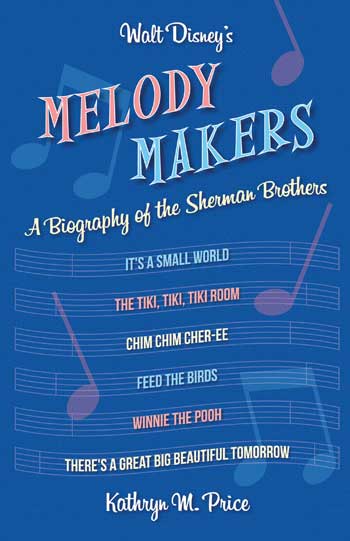Carousel of Progress. “it’s a small world”. Walt Disney’s Enchanted Tiki Room. Journey Into Imagination. These classic Disney attractions have one important thing in common — they all contain brilliant songs by the Sherman Brothers. I cannot imagine any of those experiences without the memorable tunes that go along with them. For example, the original Imagination ride is long gone, but we all remember the way the music led us through the entire show.
Richard and Robert Sherman enjoyed a diverse and distinguished career that went far beyond their impact on Disney’s theme parks. It’s easy to forget many of their contributions and just concentrate on Mary Poppins and the parks. Those examples barely scratch the surface of the Sherman Brothers’ work. Kathryn M. Price’s new book Walt Disney’s Melody Makers helps to rectify those omissions. This well-researched biography offers an engaging, warm look at the life of two composers that helped create so much of Disney’s memorable offerings.
Celebrating Life
Published in January by Theme Park Press, this book provides an upbeat look at the brothers’ celebrated career. My understanding of their life comes mostly from the excellent 2009 documentary The Boys: The Sherman Brothers Story. That film was directed by the sons of Richard and Robert, so it looked inward and delved into personal conflicts. Price does not cover similar material in this book. Instead, she provides an appealing tale about their success. That doesn’t mean that challenges are diminished; they just aren’t the focus of this positive tale.
Price does a nice job in the early chapters documenting the brothers’ family history. It’s easy to jump right into their time at Disney, but she doesn’t rush it. These chapters interest me because I know the least about this time period. The background of their father Al Sherman provides a solid context for their talents. It took a while before the brothers found their footing in the business, however. In a similar vein to Walt Disney’s life, it’s easy to think of the brothers as finding success quickly. Their Annette Funciello’s hit “Tall Paul” did not arrive until 1958.
One blind spot for me is the extent of the brothers’ work composing songs for Annette Funicello. They wrote 36 songs for her across a wide range of genres, including ones for her role on Zorro. Her genuine style connected to the way the Bob and Richard constructed a song. Their lyrics were direct and a little cheesy by today’s standards, yet they remain with you. I haven’t seen the movie since I was a kid, but a silly song like “The Monkey’s Uncle” remains stuck in my mind.
Working with Walt
I cannot get enough of stories about Walt, particularly when they come from different perspectives. It’s great to read about the experiences for Richard and Bob in working for Walt. His signature reply of “that’ll work” when he’s satisfied had to confuse plenty of his employees. Price does a good job depicting the growing relationship between Walt and the boys. It’s surprising to note how much creative input that Richard and Bob had in the films and attractions they supported. As employees of the Disney Company, they were a lot more than hired hands.
Price spends a lot of time describing the production of Mary Poppins, and for good reason. It’s one of Disney’s greatest films, and the brothers’ work plays a key role. The movie holds up very well today because the music and themes connect so well. It’s hardly just a kids’ picture, either. These chapters do a lot more than just describe the work from Richard and Bob on the film. We also learn about the difficulties with P.L. Travers, innovative effects work, and the casting process. It’s an effective overview of the complex production.
I will never tire of reading background on classic Disney attractions, and there is information on the Tiki Room, Carousel of Progress, and more in this book. The chapter on the 1964 World’s Fair (including It’s a Small World) contains plenty of interesting material. The brothers did so much successful work in the 1960s, and much of it remains prominent today. Their collaboration with Walt took the music to new heights. I love the video of Richard and Bob singing “There’s a Great Big Beautiful Tomorrow” with Walt for the GE pitch.
A Continuing Legacy
Walt’s tragic death in 1966 shocked everyone, and the Disney Company changed forever. “The Day the Light Went Out” chapter captures that sad time for the brothers, who had a close bond with Walt. This is hardly the end of the story, however. Price reminds us of how much they accomplished beyond the work for Disney through other films and on Broadway. They also returned for pivotal work on Epcot in the early ‘80s. Walt Disney’s Melody Makers provides an enjoyable look at the Sherman Brothers’ career and why they remain so important today.
On the Tomorrowland Blu-Ray release, a bonus feature shows Richard Sherman visiting the studio for a new recording of “There’s a Great Big Beautiful Tomorrow”. Its use in that film’s World’s Fair scene perfectly sets the mood to help recreate 1964. That extra also shows how important meeting Richard is to Director Brad Bird and Composer Michael Giacchino. It’s clearly the highlight of their day and another reminder of the brothers’ impact. Richard and Bob wrote songs that still resonate 50 years later and will likely be around long after we are gone.
Purchase a print copy through Amazon.
Related Articles
Celebrate the Future: An Epcot Playlist
5 Ways to Fix the Carousel of Progress’ Final Scene
Tomorrow Society Podcast, Episode 33: Composer Bruce Broughton
This post contains affiliate links. Making any purchase through those links supports this site. See full disclosure.




Leave a Reply